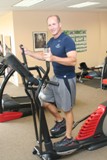 A study questioning the usefulness of arthroscopic surgery for osteoarthritis of the knee should encourage patients to consider physical therapy as an effective non-surgical option, according to the American Physical Therapy Association (APTA). The study was published in the New England Journal of Medicine (NEJM). The study found that physical therapy, combined with comprehensive medical management, is just as effective at relieving the pain and stiffness of moderate to severe osteoarthritis of the knee as surgery.
A study questioning the usefulness of arthroscopic surgery for osteoarthritis of the knee should encourage patients to consider physical therapy as an effective non-surgical option, according to the American Physical Therapy Association (APTA). The study was published in the New England Journal of Medicine (NEJM). The study found that physical therapy, combined with comprehensive medical management, is just as effective at relieving the pain and stiffness of moderate to severe osteoarthritis of the knee as surgery.
“This study offers hope and encouragement to persons with osteoarthritis who would like to avoid the pain and emotional toll of surgery,” said APTA President R. Scott Ward, PT, PhD. “Too often, the first line of defense is surgery when it need not always be. Physical therapy can be equally effective and should be considered by not only patients themselves, but also the primary care doctors and orthopedists who are treating them.”
According to physical therapist Christopher M Powers, PhD, PT, director of the Biokinesiology program and co-director of the Musculoskeletal Biomechanics Research Lab at the University of Southern California Division of Biokinesiology & Physical Therapy, “Many times knee pain is associated with abnormal movement patterns that cause increased stress on the joint. Arthroscopic surgery does little to correct the dynamic factors that may be contributing to knee pain and pathology. These findings reinforce the need for a comprehensive treatment approach for such patients.”
The NEJM study adds to a growing body of evidence supporting physical therapy for treatment of osteoarthritis of the knee, including:
— A report published in the January 2008 issue of the journal Physical Therapy that reviewed research on osteoarthritis of the knee from 2000 to 2007 and found “high-quality evidence that exercise and weight reduction reduce pain and improve physical function.”
— A study published in the Feb 1, 2000 issue of the Annals of Internal Medicine that concluded “a combination of manual physical therapy and supervised exercise yields functional benefits for patients with osteoarthritis of the knee and may delay or prevent the need for surgical intervention.”
A physical therapist will perform a thorough examination and design a plan of care that may include:
- A series of exercises designed to help improve motion. Activities in this phase might include water walking, swimming, and flexibility exercises.
- An exercise sequence to restore strength including a functional progression, that is, a gradual return to normal activities using exercises that simulate the knee stresses of your normal activities.
A knee’s tolerance for stressful activities often decreases with age and loss of conditioning. As a result, stresses that would not have caused pain or injury to the knee last year could today. A decrease in levels of activity over a period of time may also contribute to the vulnerability of knees.
But there are steps one can take to help prevent injury in order to continue enjoying sports and exercise. Pursuing an exercise program designed by a physical therapist can be one of the best protections from injury.
The first step in designing your exercise program is an evaluation by your physical therapist. He or she can identify your predisposing factors, those body traits that may make you more or less vulnerable to a knee injury. Based on this evaluation, your physical therapist can design a program that will help you gain your optimum levels of function, strength and conditioning.
Physical therapy plays a key role in treating and rehabilitating the knee, but the patient’s attitude toward recovery plays a big factor in achieving a successful outcome. For more information on taking care of your knees and to find a physical therapist, visit www.apta.org/consumer.
APTA (http://www.apta.org/) is a national organization representing physical therapists, physical therapist assistants, and students nationwide. Its goal is to foster advancements in physical therapist education, practice, and research. Consumers can visit www.findapt.us to find a physical therapist in their area, as well as www.apta.org/consumer for physical therapy news and information.













